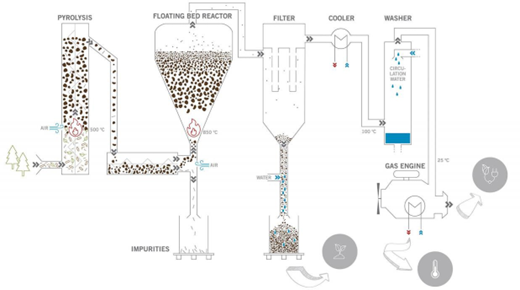Gasifier
Syncraft Gasifier
Introduction
Gasification is a process that turns carbonaceous materials derived from biomass or fossil fuels into gases, with nitrogen (N2), carbon monoxide (CO), hydrogen (H2), and carbon dioxide (CO2) making up the main components (CO2). This is accomplished by regulating the quantity of oxygen and/or steam present in the reaction and heating the feedstock material to high temperatures (usually >700 °C) without combustion. Due to the flammability of the H2 and CO, which make up a substantial portion of the combination, the resultant gas is known as syngas (from synthesis gas) or producer gas and is itself a fuel. If the gasified chemicals were made from biomass feedstock, then the following burning of the resulting gas is thought to be a source of renewable energy.
The gasifier used for the ROBINSON project's case is a Syncraft Gasifier.
Syncraft Gasifier
Technical Description
A Syncraft gasifier is being evaluated for wood gasification, producing syngas that will be blended in the gas fuel mixer and then delivered to the CHP unit. Several procedures are used by the gasification unit to turn wood into syngas. The Syncraft gasifier is particularly versatile in terms of feedstock; any forest leftovers may be fed into the gasifier, eliminating the need of expensive feedstock such as pure wood pellets. This raw material feedstock flexibility and excellent conversion efficiency is made possible by fixed bed gasification technology. On the contrary, the gasification unit's operating flexibility is limited. As a result, slow start-up periods of roughly 20-30 minutes and cold start-up times of more than three hours are common.
Gasification is a process that turns carbonaceous materials derived from biomass or fossil fuels into gases, with nitrogen (N2), carbon monoxide (CO), hydrogen (H2), and carbon dioxide (CO2) making up the main components (CO2). This is accomplished by regulating the quantity of oxygen and/or steam present in the reaction and heating the feedstock material to high temperatures (usually >700 °C) without combustion. Due to the flammability of the H2 and CO, which make up a substantial portion of the combination, the resultant gas is known as syngas (from synthesis gas) or producer gas and is itself a fuel. If the gasified chemicals were made from biomass feedstock, then the following burning of the resulting gas is thought to be a source of renewable energy.

Indicative depiction of a Syncraft gasifier
Technology Flowchart

The gasification process of the Syncraft gasifier
Technology requirements and operating conditions
The type and size of gasifier are currently being considered. The table summarizes the process and operating parameters known at the time of reporting. These are scheduled to be changed as soon as:
- Feedstock is described since it determines whether extra gas cleaning is required, which may be the case if treated waste wood is used as a feedstock.
- The provider conducts gasification testing.
The raw materials are initially transformed using a pyrolysis process, which involves heating the wood resources to 1,000 °C, resulting in the raw materials decomposing into gases and charcoal (or biochar). When applied to soils, biochar (possibly) provides for negative GHG emissions, and it might be useful to compensate for difficult to decarbonize (industrial) operations in ROBINSON (Terlouw et al., 2021).
The floating bed reactor next filters out contaminants. Furthermore, it uses gravity in the floating fixed bed reactor to select gas particles containing hydrogen, carbon monoxide, carbon dioxide, and light. Following that, the gas may be utilized to power a gas engine, which will provide heat and electricity. In addition, the gas and charcoal can be utilized as feedstock in subsequent operations. The biomass dryer, air compressor, air blower, and water pumps all require electricity (Molino et al., 2016).
Operational parameters of the gasification unit
|
Parameter |
Value |
|
Nominal energy input (waste wood chips) |
1800 kW |
|
Thermal power, water temp. 100°C |
200 kW |
|
Fuel demand |
360 kg/hour |
|
Max net. delivered fuel energy output (syngas) |
1260 kW (788 Nm3/hour) |
|
Operating temperature |
1000oC |
|
Delivery temperature |
30oC |
|
Delivery pressure |
150 mbarg |
|
Composition of syngas |
CH4: 3 vol%, H2: 21 vol%, CO: 20 vol%, CO2: 12 vol%, N2: 44 vol% |
|
Electrical power need |
20 kW |
|
Fresh water demand |
2 – 3 m3/day |
|
Cooling demand (scrubber) |
54 kW |
|
Cold start up time |
At least 3 hours |
|
Hot start up |
23 – 30 minutes |
|
Operational flexibility |
Low, permanent operation is standard |
|
Interruption of feedstock flow |
the syngas stored in the buffer gas tank is fed to the gas turbine and after ca. 5 min it is stopped (when the pressure is fallen below the set 120 mbar) |
|
Service and maintenance |
After 8000 hr: onsite service by SynCraft After 2000 hr: minor service by local work force |
